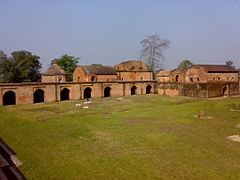Architectural style Tai Ahom Architecture Completed 1769 Opened 1769 Structural system Brick | Location SivasagarAssamIndia Architect Ghanashyam Construction started 1751 | |
 | ||
Similar Rang Ghar, Kareng Ghar, Sivasagar Sivadol, Garchuk Lachit Garh, Agnigarh | ||
Sivasagar talatal ghar
The Talatal Ghar (Assamese: তলাতল ঘৰ [tɔlatɔl ɡʱɔɹ]) is located in Rangpur, 4 km from present-day Sivasagar, in Upper Assam. Of all Ahom ruins, it is one of the grandest examples of Tai Ahom architecture. The Talatal Ghar, together with its above-ground counterpart the Kareng Ghar, is also the largest of all Tai Ahom monuments.
Contents
- Sivasagar talatal ghar
- Map of Talatal Ghar Barpatra Dol Kalugaon Assam 785665
- Talatal ghar sivasagar historical monument of assam
- History
- Architecture
- References
Map of Talatal Ghar, Barpatra Dol Kalugaon, Assam 785665
Visitors nowadays can only view the ground floor, the first floor, and what remains of the 2nd and 3rd floors of the Kareng Ghar. The floors of the Talatal Ghar below the ground have been sealed off.
Talatal ghar sivasagar historical monument of assam
History
Swargadeo Rudra Singha shifted the capital of the Ahom Kingdom from Garhgaon to Rangpur in AD 1702-03. For about a century thereafter, Rangpur remained the capital. It is located in the western part of Sivasagar. The earliest constructions were commissioned by Swargadeo Rudra Singha in AD 1698. Rangpur was the capital of the Ahom Kingdom and served as its military-station.
Architecture
The Talatal Ghar is a palace which was initially built as an army base. It houses two secret tunnels, and three floors below ground level which were used as exit routes during the Ahom wars (and which give the structure its name).
After Swargadeo Rudra Singha's death the Talatal Ghar, which together with the above-ground Kareng Ghar constitutes the "Rangpur Palace", went through many architectural alterations to its structure, which resulted in its irregular shape.
Rangpur Palace
Talatal Ghar
Kareng Ghar
However the first Ground Penetrating Survey (GPR) in the northeast, undertaken at two Ahom monuments in Sivasagar district in early Apr 2015, has not revealed the existence of any secret tunnel. The survey was carried out by IIT-Kanpur, in collaboration with the Guwahati circle of the Archaeological Survey of India (ASI), over a period of five days at Talatal Ghar and Ahom Royal Palace (Kareng Ghar), both in Sivasagar district.
Visitors nowadays can only view the ground floor, the first floor, and what remains of the 2nd and 3rd floors of the Kareng Ghar. The floors of the Talatal Ghar below ground have been sealed off, and most of the wooden parts of the palace have disappeared over time.
The Rangpur Palace was once surrounded by a brick fortification and an earthen fort (Garh) with dikes filled with water. There is a Khar Ghar (gunpowder and ammunition store) near the palace.
